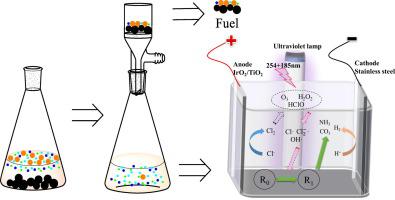Our official English website, www.x-mol.net, welcomes your
feedback! (Note: you will need to create a separate account there.)
Experiment study on the separation of bituminous coal adsorption and the synergism of ultraviolet and electrochemistry in the pretreatment of coal chemical wastewater
Fuel ( IF 6.7 ) Pub Date : 2021-03-01 , DOI: 10.1016/j.fuel.2020.119712 Qizheng Qin , Han Yang , Hongxiang Xu , Jiushuai Deng , Rong Zhao , Gen Huang , Penghui Wang , Jingzheng Wang
Fuel ( IF 6.7 ) Pub Date : 2021-03-01 , DOI: 10.1016/j.fuel.2020.119712 Qizheng Qin , Han Yang , Hongxiang Xu , Jiushuai Deng , Rong Zhao , Gen Huang , Penghui Wang , Jingzheng Wang

|
Abstract Although clean coal utilization has attracted much attention, it is challenging to treat coal chemical wastewater. In this work, the coking wastewater was treated by bituminous coal adsorption and composite advanced oxidation technology. The effect of adsorption on organic separation and the synergy between UV and electrochemistry were investigated. The results indicated that the removal of total organic carbon (TOC), chroma, and UV254 by bituminous coal adsorption was effective. And polycyclic aromatic hydrocarbons were preferentially adsorbed, followed by phenols and aliphatic hydrocarbons. After bituminous coal adsorption and electrochemical/UV/H2O2 treatment, the TOC of coking wastewater decreased by 68.92%, which was better than adsorption/electrochemical and adsorption/UV. Through excitation-emission matrix (EEM) and gas chromatography-mass spectrometry (GC–MS) analysis, the improvement of biodegradability was attributed to the reduction of polycyclic aromatic hydrocarbons, long-chain alkane, and nitrogen heterocyclic compounds in the coking wastewater. UV photocatalysis and electrochemical had synergistic effects on the degradation of polycyclic aromatic hydrocarbons. Besides, the active chlorine could be regulated by adjusting the current density and the dosage of hydrogen peroxide.
中文翻译:

烟煤吸附分离及紫外电化学协同在煤化工废水预处理中的实验研究
摘要 煤炭清洁利用虽然备受关注,但煤化工废水的处理仍具有挑战性。本研究采用烟煤吸附和复合高级氧化技术处理焦化废水。研究了吸附对有机分离的影响以及紫外和电化学之间的协同作用。结果表明,烟煤吸附去除总有机碳(TOC)、色度和UV254是有效的。多环芳烃被优先吸附,其次是酚类和脂肪烃。烟煤吸附和电化学/UV/H2O2处理后,焦化废水TOC降低68.92%,优于吸附/电化学和吸附/UV。通过激发-发射矩阵(EEM)和气相色谱-质谱(GC-MS)分析,生物降解性的提高归因于焦化废水中多环芳烃、长链烷烃和含氮杂环化合物的减少。紫外光催化和电化学对多环芳烃的降解具有协同作用。此外,还可以通过调节电流密度和过氧化氢用量来调节活性氯。紫外光催化和电化学对多环芳烃的降解具有协同作用。此外,还可以通过调节电流密度和过氧化氢用量来调节活性氯。紫外光催化和电化学对多环芳烃的降解具有协同作用。此外,还可以通过调节电流密度和过氧化氢用量来调节活性氯。
更新日期:2021-03-01
中文翻译:

烟煤吸附分离及紫外电化学协同在煤化工废水预处理中的实验研究
摘要 煤炭清洁利用虽然备受关注,但煤化工废水的处理仍具有挑战性。本研究采用烟煤吸附和复合高级氧化技术处理焦化废水。研究了吸附对有机分离的影响以及紫外和电化学之间的协同作用。结果表明,烟煤吸附去除总有机碳(TOC)、色度和UV254是有效的。多环芳烃被优先吸附,其次是酚类和脂肪烃。烟煤吸附和电化学/UV/H2O2处理后,焦化废水TOC降低68.92%,优于吸附/电化学和吸附/UV。通过激发-发射矩阵(EEM)和气相色谱-质谱(GC-MS)分析,生物降解性的提高归因于焦化废水中多环芳烃、长链烷烃和含氮杂环化合物的减少。紫外光催化和电化学对多环芳烃的降解具有协同作用。此外,还可以通过调节电流密度和过氧化氢用量来调节活性氯。紫外光催化和电化学对多环芳烃的降解具有协同作用。此外,还可以通过调节电流密度和过氧化氢用量来调节活性氯。紫外光催化和电化学对多环芳烃的降解具有协同作用。此外,还可以通过调节电流密度和过氧化氢用量来调节活性氯。











































 京公网安备 11010802027423号
京公网安备 11010802027423号